Shoulder stabilisation exercises enhance joint stability, prevent injuries, and improve posture. They are essential for athletes, individuals with shoulder pain, and post-surgical rehabilitation, promoting long-term shoulder health through structured movements.
1.1 Importance of Shoulder Stability
Shoulder stability is crucial for preventing injuries, enhancing athletic performance, and maintaining proper joint alignment. It ensures the scapula and humerus function in harmony, reducing the risk of impingement and chronic pain. Strong shoulder stability promotes efficient movement patterns, protects the rotator cuff, and supports overall upper body strength. Without proper stability, daily activities and sports can lead to strains or long-term damage, emphasizing the need for targeted exercises to strengthen the muscles around the shoulder joint and improve scapular control. This foundation is essential for injury prevention, rehabilitation, and maintaining optimal shoulder health for both athletes and individuals with shoulder pain.
1.2 Benefits of Shoulder Stabilisation Exercises
Shoulder stabilisation exercises offer numerous benefits, including improved joint mechanics, injury prevention, and enhanced athletic performance. They strengthen the rotator cuff and scapular muscles, reducing the risk of impingement and chronic pain. These exercises promote proper posture, improve dynamic stability, and restore functional movement patterns. For athletes, they enhance performance and reduce injury risk, while for individuals with shoulder pain, they provide relief and improve mobility. Post-surgical rehabilitation benefits from these exercises as they restore strength and stability, aiding in a faster recovery. Regular practice also improves overall upper body strength and coordination, making daily activities easier and reducing the likelihood of long-term shoulder damage.
1.3 Target Audience: Athletes, Individuals with Shoulder Pain, and Post-Surgical Rehabilitation
Shoulder stabilisation exercises are tailored for athletes seeking enhanced performance and injury prevention, individuals with shoulder pain aiming to alleviate discomfort, and those in post-surgical rehabilitation. Athletes benefit from improved joint stability and strength, reducing the risk of injuries during high-demand activities. Individuals with shoulder pain find relief through exercises that restore proper mechanics and reduce strain. Post-surgical patients use these exercises to rebuild strength and stability, ensuring a successful recovery. The structured progression of exercises addresses each group’s specific needs, promoting long-term shoulder health and functionality. This comprehensive approach ensures that individuals from various backgrounds can safely and effectively improve their shoulder stability and overall well-being.
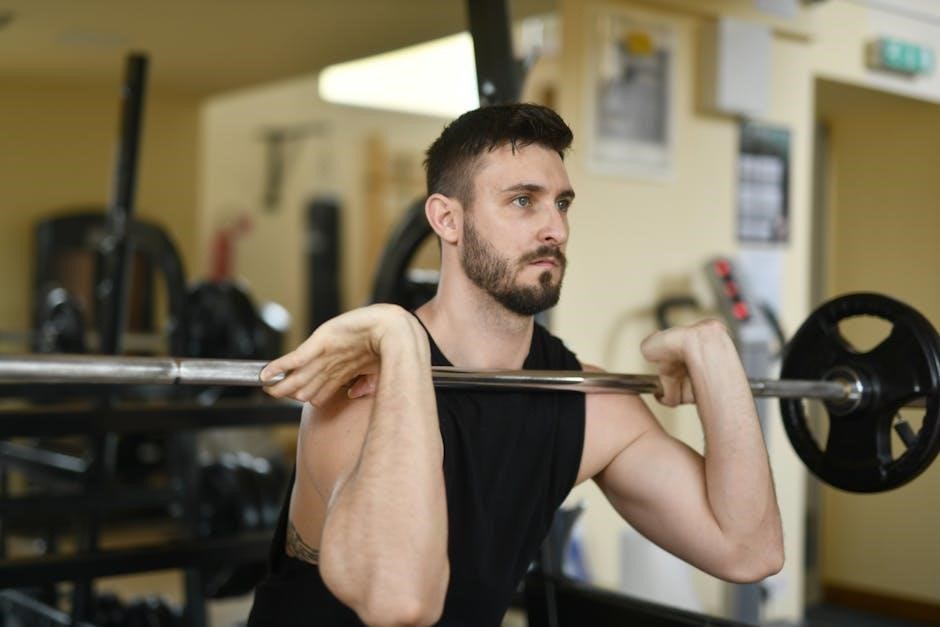
Understanding Shoulder Anatomy and Mechanics
The shoulder joint, comprising the humerus, scapula, and clavicle, relies on the rotator cuff and scapular muscles for stability and mobility, enabling a wide range of motion.
2.1 The Shoulder Joint and Its Components
The shoulder joint, a complex ball-and-socket joint, consists of the humerus, scapula, and clavicle. The glenohumeral joint connects the humerus to the scapula, providing a wide range of motion. The joint is stabilized by the labrum, ligaments, and tendons, while cartilage ensures smooth movement. The rotator cuff muscles—supraspinatus, infraspinatus, teres minor, and subscapularis—play a crucial role in dynamic stability. The scapula acts as the base, enabling overhead movements. Proper alignment and coordination between these components are essential for preventing injuries and maintaining functional mobility, making them a focus in shoulder stabilisation exercises.
2.2 Role of the Scapula in Shoulder Stability
The scapula serves as the foundation for shoulder stability, providing a base for the glenohumeral joint. Its proper positioning and movement are crucial for effective shoulder function. Muscles like the trapezius, rhomboids, and levator scapulae control the scapula, ensuring it moves in sync with the humerus. During arm movements, the scapula rotates and tilts to maintain joint alignment. Dysfunctional scapular movement, such as winging or downward rotation, can lead to instability and injury. Strengthening scapular stabilizers enhances overall shoulder stability, reducing the risk of impingement and improving posture. Proper scapular mechanics are essential for optimal shoulder function, making them a key focus in stabilisation exercises.
2.3 The Rotator Cuff and Its Function
The rotator cuff consists of four muscles—the supraspinatus, infraspinatus, teres minor, and subscapularis—that work together to stabilize the shoulder joint. These muscles provide dynamic control, ensuring proper alignment of the humerus in the glenoid cavity during movements. The supraspinatus initiates abduction, while the infraspinatus and teres minor assist in external rotation and stability. The subscapularis facilitates internal rotation and prevents anterior dislocation. Together, they act as a stabilizing force, enabling smooth, precise movements. Weakness or injury to the rotator cuff can lead to instability, pain, and limited mobility. Strengthening these muscles is critical for maintaining shoulder health and preventing injuries, making them a focal point in stabilisation exercises.
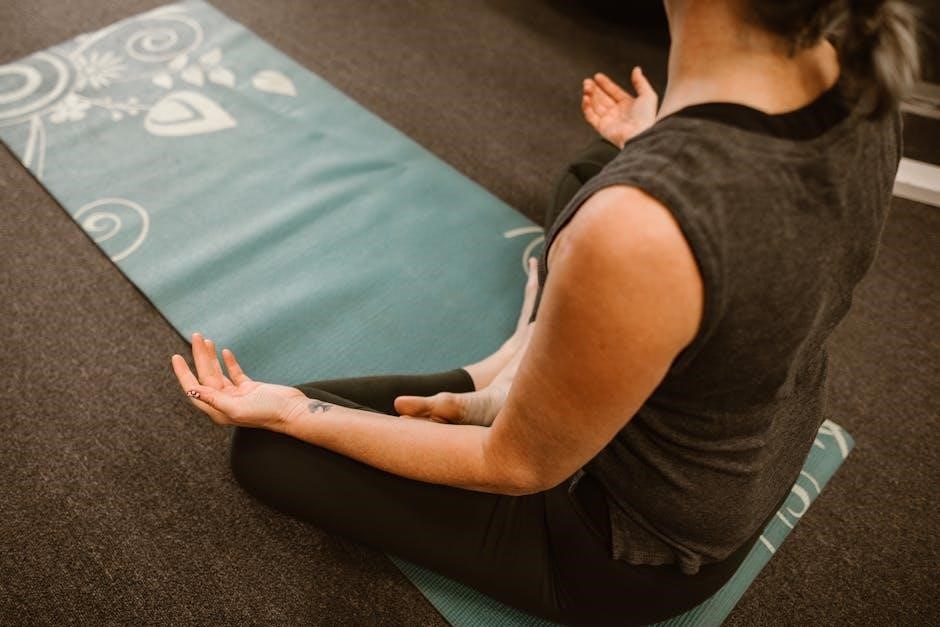
Phases of Shoulder Stabilisation Exercises
Shoulder stabilisation exercises progress through four phases: foundational scapular stability, rotator cuff strengthening, dynamic stabilisation, and advanced functional exercises, ensuring gradual improvement in shoulder stability and function.
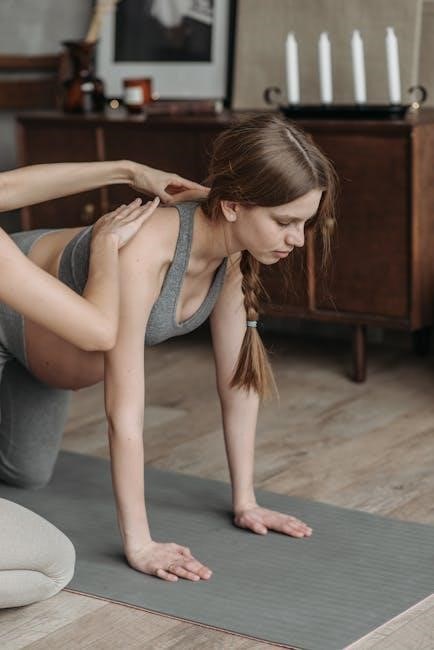
3.1 Phase I: Foundational Scapular Stability
Phase I focuses on building foundational scapular stability through exercises like scapular retractions and shoulder blade squeezes. These movements strengthen the muscles around the shoulder blade, improving posture and reducing injury risk. Patients are taught to maintain proper form, engaging the scapula without shrugging. Wall slides and prone scapular exercises are also introduced to enhance scapular control. This phase lays the groundwork for more advanced movements by ensuring the scapula moves efficiently and maintains proper positioning during arm activities. Regular practice of these exercises improves joint stability and overall shoulder function, creating a strong foundation for progressing to subsequent phases.
3.2 Phase II: Strengthening the Rotator Cuff
Phase II focuses on strengthening the rotator cuff muscles, including the supraspinatus, infraspinatus, teres minor, and subscapularis. Exercises such as internal and external rotations using Therabands or light weights are introduced. Standing forward flexion (full-can exercise) and prone scaption (Ys) are also incorporated to enhance dynamic stability. Emphasis is placed on controlled movements to avoid impingement. This phase builds on the scapular stability achieved in Phase I, progressing to more challenging movements that improve strength and coordination for functional activities. Regular practice strengthens the rotator cuff, enhancing joint stability and preparing the shoulder for more advanced exercises in subsequent phases.
3.3 Phase III: Dynamic Stabilisation
Phase III introduces dynamic stabilisation exercises to enhance the shoulder’s ability to maintain stability during movement. Exercises like the clock exercise and resistance band rotations challenge the rotator cuff and scapular muscles in dynamic scenarios. These movements improve proprioception and functional strength, preparing the shoulder for real-world activities. Emphasis is placed on controlled, precise movements to ensure proper form and prevent compensation patterns. This phase bridges the gap between basic strengthening and advanced functional exercises, fostering greater shoulder resilience and coordination. Regular practice enhances overall shoulder function and posture, making it ideal for individuals progressing from foundational exercises to more complex movements.
3.4 Phase IV: Advanced Functional Exercises
Phase IV focuses on advanced functional exercises that mimic real-life movements and sports-specific actions. Activities like overhead presses, weighted scapular stabilizations, and dynamic rotations are introduced to challenge the shoulder in complex patterns; These exercises aim to restore full functional capacity, preparing the individual for unrestricted activity. Progression is gradual, ensuring the shoulder remains stable and strong during high-demand tasks. This phase emphasizes integration of strength, flexibility, and coordination, achieving optimal shoulder performance for daily activities or athletic endeavors. Proper form and controlled movements are crucial to avoid injury and maximize effectiveness, ensuring the shoulder is resilient and capable of handling dynamic, real-world challenges.
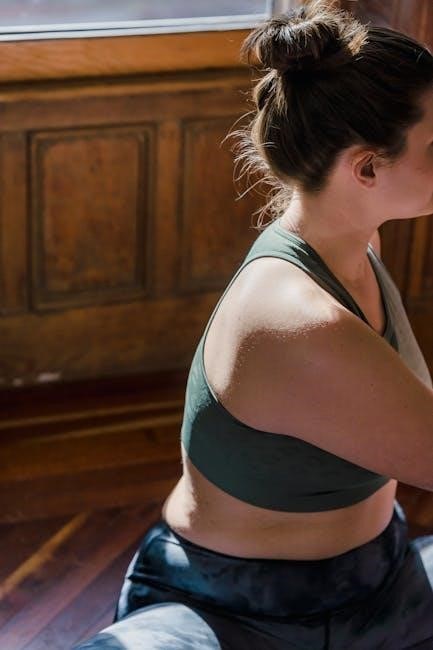
Fundamental Shoulder Stabilisation Exercises
Fundamental exercises like Scapular Retraction, Prone Scaption, Standing Forward Flexion, and Wall Slides improve posture, reduce injury risk, and enhance shoulder stability for athletes and individuals with shoulder pain.
4.1 Scapular Retraction
Scapular Retraction strengthens the muscles between the shoulder blades, improving posture and stability. Stand tall, squeeze shoulders back, and hold for 5 seconds. Perform 3 sets of 10 reps. Keep abs tight and avoid shrugging. This exercise enhances scapular control and reduces injury risk. It’s a foundational movement for shoulder health, often used in rehabilitation and strength programs. Proper form ensures effectiveness and prevents strain. Regular practice improves joint stability and overall shoulder function. This exercise is ideal for individuals with shoulder pain or post-surgical rehabilitation, promoting long-term shoulder health and stability through consistent practice.
4.2 Prone Scaption
Prone Scaption strengthens the rotator cuff and scapular muscles, improving posture and reducing shoulder pain. Bend at the waist with the affected arm hanging straight down. Raise the arm in a Y shape to shoulder height, keeping the elbow straight, and hold for 2-3 seconds. Perform 3 sets of 10 reps; Avoid lifting the arm too high to prevent strain. This exercise is essential for enhancing dynamic stability and promoting overall shoulder health. Proper form is crucial to maximize effectiveness and avoid injury. Regular practice helps restore strength and coordination, making it ideal for rehabilitation and daily shoulder maintenance. Consistency is key to achieving lasting benefits and improving joint function.
4.3 Standing Forward Flexion
Standing Forward Flexion strengthens shoulder muscles and improves stability. Stand with good posture, raise your arm forward to shoulder height, keeping it straight. Hold for 2-3 seconds, then slowly lower it. Avoid raising above shoulder level. Perform 3 sets of 10 reps. Proper form is crucial to avoid impingement. This exercise is effective for overhead activities and injury prevention. Focus on slow, controlled movements for optimal results. Regular practice enhances strength and dynamic control, making it ideal for rehabilitation and daily shoulder maintenance. Ensure slow, controlled movements to maximize effectiveness and prevent strain. This exercise is beneficial for improving joint stability and overall shoulder function in daily activities and sports.
4.4 Wall Slides
Wall Slides are an effective exercise for improving scapular control and shoulder stability. Stand with your back against a wall, feet shoulder-width apart. Slowly slide your arms upward, keeping your shoulders down and away from your ears. Hold for 5 seconds, then lower your arms. Repeat 10-12 times. Ensure proper posture throughout. This exercise improves scapular control and shoulder stability, reducing the risk of impingement. Focus on controlled movements to maximize effectiveness. Wall slides are ideal for strengthening shoulder muscles and enhancing dynamic stability, making them a valuable addition to any shoulder rehabilitation or strengthening program. Regular practice helps maintain proper alignment and reduces injury risk.

Dynamic Shoulder Stabilisation Exercises
Dynamic shoulder stabilisation exercises enhance joint stability during movement, improving scapular control and rotator cuff function. Ideal for athletes and rehabilitation, they promote functional strength and injury prevention through controlled, precise movements.
5.1 The Clock Exercise
The clock exercise is a dynamic stabilisation drill that enhances scapular control and shoulder stability. Imagine a clock face on the side of your shoulder. Start with shoulders relaxed, then raise them toward the 12 o’clock position, holding for 2 seconds. Next, lower them to 9 o’clock, squeezing your shoulder blades together. Perform this movement slowly and controlled, avoiding shrugging. This exercise improves scapular mobility and strength, essential for dynamic shoulder stability. It is often recommended in rehabilitation programs to restore proper shoulder mechanics and prevent injuries. Regular practice enhances overall shoulder function and posture, making it ideal for athletes and individuals recovering from shoulder issues.
5.2 Resistance Band Exercises
Resistance band exercises are effective for enhancing dynamic shoulder stability by strengthening the rotator cuff and scapular muscles. Using a Theraband, perform exercises like shoulder rotations, scapular retractions, and controlled arm movements. These exercises provide external resistance, promoting muscle activation and improving joint stability. Start with light resistance and progress gradually. Focus on maintaining proper form and avoiding momentum. Regular practice with resistance bands enhances dynamic control and reduces injury risk, making them a versatile tool for shoulder rehabilitation and strength training programs. Consistency is key to achieving lasting benefits. These exercises are ideal for improving functional strength and preparing the shoulder for daily activities or athletic demands.

Strengthening the Rotator Cuff
Strengthening the rotator cuff enhances shoulder stability and prevents injuries. Targeting muscles like the supraspinatus, infraspinatus, teres minor, and subscapularis improves joint mechanics and overall shoulder function effectively.
6.1 Supraspinatus Strengthening
The supraspinatus muscle plays a key role in shoulder stability by controlling the first 15 degrees of arm abduction. Strengthening this muscle is crucial for preventing impingement and enhancing joint function. Exercises like prone scaption (Ys) and side-lying external rotations target the supraspinatus effectively. Using light weights or resistance bands, these movements improve muscle endurance and strength. Proper form is essential to avoid compensatory patterns. Starting with low resistance and gradually increasing intensity ensures safe progression. Regular practice of these exercises helps restore balance and stability to the shoulder joint, reducing the risk of injury and improving overall shoulder mechanics. Consistency is vital for achieving long-term benefits and maintaining healthy shoulder function.
6.2 Infraspinatus Strengthening
The infraspinatus muscle is a key stabilizer of the shoulder joint, aiding in external rotation and preventing excessive internal rotation. Strengthening this muscle is vital for maintaining proper shoulder mechanics and reducing injury risk; Exercises such as side-lying external rotations and standing external rotations with a resistance band effectively target the infraspinatus. Using light weights or resistance bands, these movements improve muscle strength and endurance. Proper form, including controlled movements and avoidance of compensatory patterns, is essential to maximize effectiveness. Gradual progression in resistance and repetitions ensures safe and effective strengthening. Regular practice of these exercises enhances shoulder stability, reduces the risk of impingement, and supports overall rotator cuff function, promoting long-term shoulder health and resilience.
6.3 Teres Minor Strengthening
The teres minor muscle plays a crucial role in shoulder external rotation and joint stability. Strengthening this muscle is essential for maintaining proper shoulder mechanics and preventing injuries. Effective exercises include side-lying external rotations and standing external rotations using resistance bands or light weights. These movements target the teres minor, enhancing its strength and endurance. Proper form is critical, with a focus on controlled movements and avoiding compensatory patterns. Gradual progression in resistance and repetitions ensures safe and effective strengthening. Regular practice of these exercises improves shoulder stability, reduces the risk of impingement, and supports overall rotator cuff function, promoting long-term shoulder health and resilience.
6.4 Subscapularis Strengthening
The subscapularis muscle is a key component of the rotator cuff, contributing to internal rotation and shoulder stability. Strengthening this muscle is vital for maintaining proper joint mechanics and preventing injuries. Effective exercises include internal rotations using resistance bands or light weights, as well as cross-body stretches to improve flexibility and strength. Prone scapular exercises, such as prone horizontal abductions, also target the subscapularis, enhancing its function. Proper form is essential, with a focus on controlled movements to avoid compensatory patterns. Gradual progression in resistance and repetitions ensures safe and effective strengthening. Regular practice of these exercises helps prevent imbalances, enhances shoulder stability, and supports overall rotator cuff function, promoting long-term shoulder health and resilience.

Scapular Stabilisation Techniques
Scapular stabilisation techniques focus on enhancing shoulder blade control through exercises like retractions, squeezes, and wall slides, improving posture and reducing injury risk for athletes and individuals with shoulder pain.
7.1 Scapular Retraction Exercises
Scapular retraction exercises strengthen the muscles between the shoulder blades, improving posture and stability. Stand tall, squeeze shoulders back, and hold for 5 seconds. Perform 3 sets of 10 reps. Keep abs tight and avoid shrugging. This exercise enhances scapular control and reduces injury risk. It’s a foundational movement for shoulder health, often used in rehabilitation and strength programs. Proper form ensures effectiveness and prevents strain. Regular practice improves joint stability and overall shoulder function. These exercises are ideal for individuals with shoulder pain or post-surgical rehabilitation, promoting long-term shoulder health and stability through consistent practice.
7.2 Shoulder Blade Squeeze
The shoulder blade squeeze is a simple yet effective exercise for improving scapular stability. Stand or sit with good posture, engage your core, and squeeze your shoulder blades together as if pinching a pencil between them. Hold for 5 seconds, then release. Perform 3 sets of 10 repetitions. Avoid shrugging your shoulders during the movement. This exercise strengthens the muscles between the shoulder blades, enhancing posture and reducing injury risk. It is particularly beneficial for individuals with shoulder pain or post-surgical rehabilitation. Regular practice improves scapular control and promotes long-term shoulder health. Proper form is essential to maximize effectiveness and prevent strain.
7.3 Wall Slide Variations
Wall slide variations are advanced exercises that build on foundational wall slides, targeting scapular control and shoulder stability. Stand with your back against a wall, feet shoulder-width apart. Slowly slide your arms upward, keeping your shoulders down and away from your ears. Hold for 5 seconds, then lower your arms. Perform 10-12 repetitions. Focus on controlled movements and proper posture throughout. Variations include single-arm slides or alternating arms to challenge specific muscles. These exercises enhance scapular mobility and strength, reducing injury risk. Regular practice improves dynamic stability and promotes long-term shoulder health. Ensure slow, precise movements to maximize effectiveness and avoid strain.
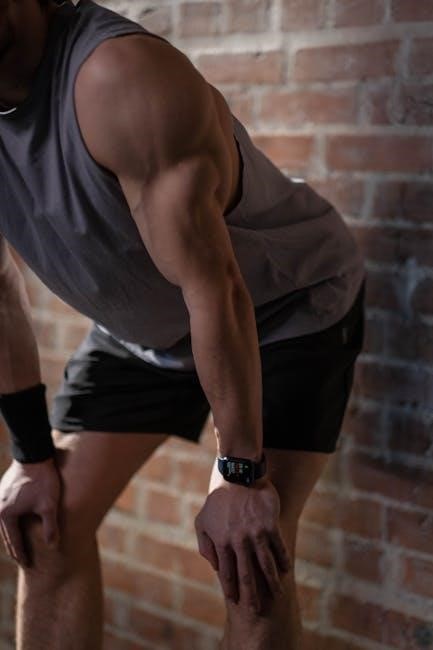
Warm-Up and Cool-Down Routines
Pre-exercise warm-ups prepare the shoulders with light cardio and dynamic stretches, while post-exercise cool-downs use static stretches and breathing exercises to aid recovery and maintain flexibility.
8.1 Pre-Exercise Warm-Up
A proper pre-exercise warm-up prepares the shoulders for activity by increasing blood flow and flexibility. Start with 5-10 minutes of light cardio, such as brisk walking or cycling, to elevate heart rate. Dynamic stretches like arm circles, shoulder rolls, and scapular retractions follow, targeting the rotator cuff and scapular muscles. These movements improve joint mobility and reduce stiffness. Gentle resistance band exercises can also be incorporated to activate the shoulder stabilizers. Avoid static stretches, as they may reduce muscle activation. The goal is to enhance neuromuscular coordination and prepare the shoulders for more intense exercises. A well-structured warm-up minimizes injury risk and optimizes performance during shoulder stabilization exercises.
8.2 Post-Exercise Stretching
Post-exercise stretching is crucial for maintaining flexibility and range of motion in the shoulders. Focus on static stretches that target the rotator cuff and scapular muscles. Hold each stretch for 20-30 seconds to allow muscle relaxation. Examples include shoulder flexion stretches, cross-body stretches, and side stretches. These exercises help reduce muscle tension and improve joint mobility. Consistency in post-exercise stretching promotes long-term shoulder health by preventing stiffness and enhancing recovery. Incorporate these stretches after your workout to support muscle balance and maintain optimal shoulder function. Regular practice ensures sustained flexibility and reduces the risk of future injuries or discomfort.

Progression of Exercises
Exercises progress by increasing resistance, advancing to dynamic movements, and incorporating functional activities, ensuring gradual development of strength and stability for optimal shoulder function and injury prevention.
9.1 Increasing Resistance and Repetitions
As shoulder exercises become easier, progress by increasing resistance or repetitions to continue challenging the muscles. For example, advance from 3 sets of 10 reps to 3 sets of 12 reps. Use Therabands or light weights to add resistance, ensuring controlled movements. If accessing a gym, incorporate weight machines under the guidance of a fitness assistant. Gradually increasing resistance strengthens the rotator cuff and scapular muscles, enhancing overall shoulder stability. This progression ensures continued improvement in strength and function, preparing the shoulder for more demanding activities while minimizing injury risk. Consistent progression is key to achieving long-term shoulder health and resilience.
9.2 Advancing to Dynamic Movements
Dynamic movements are introduced to challenge the shoulder in functional scenarios, enhancing proprioception and strength. Exercises like the clock exercise and resistance band rotations simulate real-world activities, improving coordination and stability. These movements transition from static holds to controlled, active motions, bridging the gap between basic strengthening and functional tasks. Emphasize precise, controlled actions to avoid compensation patterns. Dynamic exercises prepare the shoulder for sports-specific or daily activities, fostering resilience and adaptability. Progress gradually, ensuring proper form and engagement of the rotator cuff and scapular muscles. This phase is crucial for restoring full shoulder function and confidence in dynamic environments, reducing the risk of re-injury or strain.
9.3 Incorporating Functional Activities
Incorporating functional activities into shoulder stabilisation exercises mimics real-life movements, enhancing practical strength and flexibility. These exercises, such as overhead presses or dynamic rotations, prepare the shoulder for sports-specific or daily tasks. By integrating strength, coordination, and control, functional activities restore full shoulder function, enabling individuals to perform without limitations. Emphasize proper form and controlled movements to prevent strain. This phase ensures the shoulder is resilient and adaptable, ready for high-demand activities. Regular practice promotes long-term stability and confidence, reducing the risk of re-injury. Functional exercises are the final step in achieving optimal shoulder performance for both everyday life and athletic pursuits.
Consistent shoulder stabilisation exercises enhance joint stability, prevent injuries, and promote long-term shoulder health. They are essential for athletes, individuals with shoulder pain, and post-surgical recovery, ensuring optimal function and mobility.
10.1 Long-Term Benefits of Shoulder Stabilisation
Consistent shoulder stabilisation exercises provide lasting benefits, including enhanced joint stability, improved posture, and reduced risk of injuries. They strengthen the rotator cuff and scapular muscles, promoting better mobility and reducing chronic pain. Over time, these exercises improve athletic performance, prevent impingement, and support daily activities. Regular practice fosters long-term shoulder health, minimizing the need for medical interventions; By maintaining proper alignment and muscle balance, shoulder stabilisation exercises ensure resilience against strains and injuries, offering a foundation for lifelong upper body strength and functionality. This proactive approach not only enhances physical capabilities but also improves overall quality of life by preventing debilitating shoulder conditions.
10.2 Maintenance and Prevention Strategies
Regular shoulder stabilisation exercises are crucial for maintaining joint health and preventing future injuries. Incorporating these exercises into a daily or weekly routine ensures sustained strength and stability. Proper posture, controlled movements, and gradual progression of resistance are key to long-term benefits. Consistency in performing exercises like scapular retractions and rotator cuff strengthening helps maintain muscle balance and joint alignment. Preventative strategies include avoiding repetitive overhead movements without proper warm-up and incorporating dynamic stretches into daily routines. By prioritising shoulder health, individuals can reduce the risk of chronic pain and impingement, ensuring optimal functionality for both athletic and everyday activities. Regular practice fosters resilience and supports an active lifestyle.

